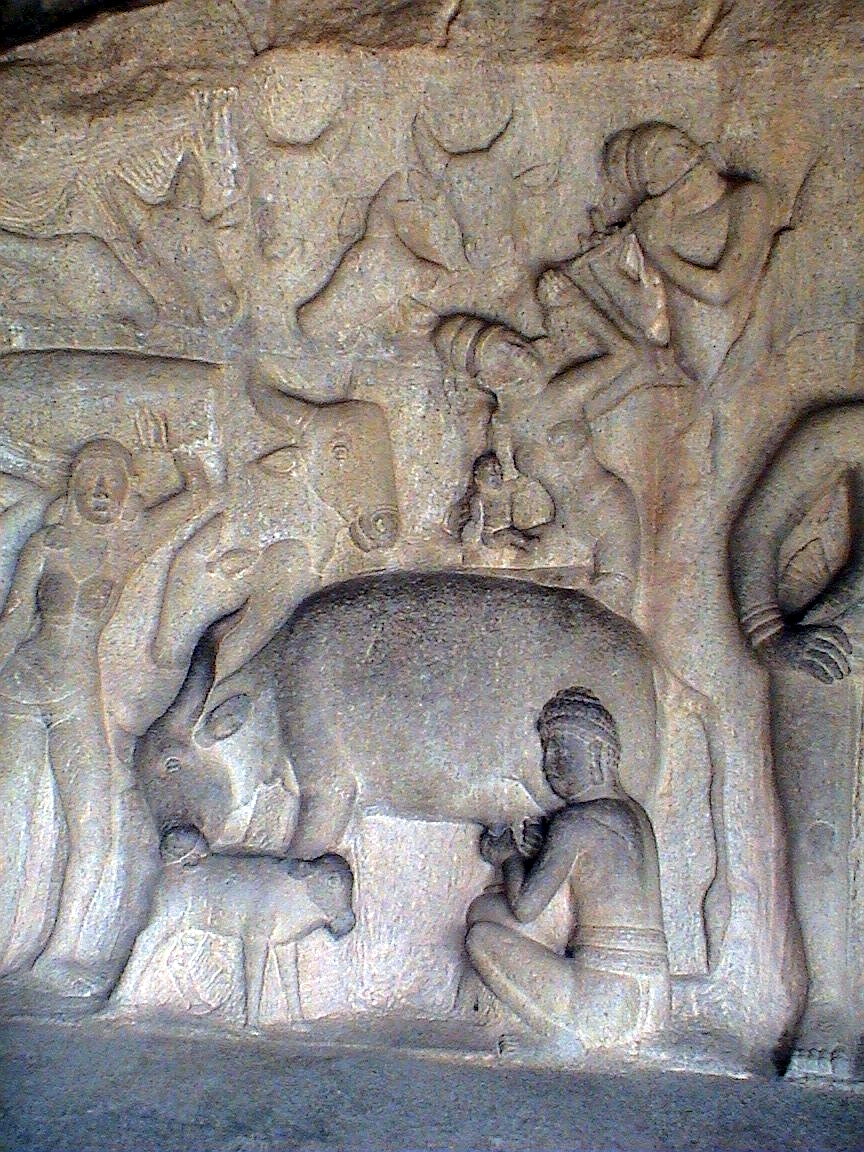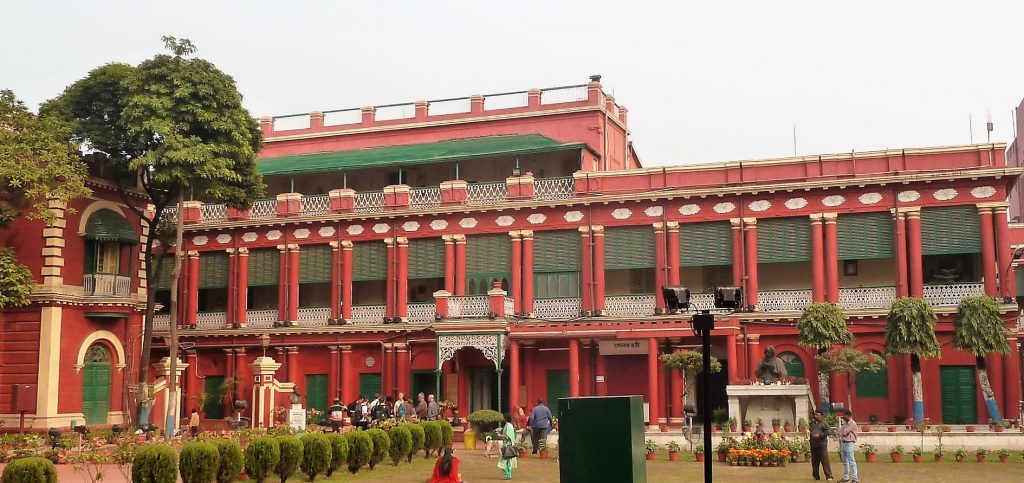Women in Hindu society generally take on a role of and are identified as householders, thus providing for a husband and family. However, some women, though a clear minority, choose a different life path which is the life of the ascetic. An ascetic is regarded as someone who abstains from worldly pleasures often in search of spiritual goals through renunciation (Denton 2). Ascetics seek to free themselves from the cycle of rebirth entirely and thereby reach salvation. Although there are a variety of ascetic forms such as celibacy and tantrism, renunciation and the sannyasas or sannyasinis are the most recognizable.
The term sannyasa (male) or sannyasini (female) means ‘abandonment’ or ‘laying aside completely’. Entry into this lifestyle involves a dramatic ritual to symbolically discard the world in which they currently live. To take on the role of a sannyasini one must establish their ritual death. This is done by figuratively cremating oneself or performing their one’s own funeral rites and also by uttering the phrase “None belongs to me, to none do I belong” or a simpler yet no less powerful phrase “I leave absolutely everything behind” (Denton 94). Initiation ceremonies into ascetic life differ from one ascetic to the next, but ritual details such as offering balls of rice to ancestors and creating grass statues of themselves which they later burn to symbolically represent cremation, remain consistent elements to the initiation process (Leslie 219). This initiation ritual into asceticism marks the rejection or separation from householdership; a commitment to a particular path towards ideals such as liberation (moksa), acquiring knowledge of the Absolute (Brahman) or salvation (mukti) through union; and the admittance into a community of fellow ascetics. This initiation process completely relieves a woman of their original social identity and alters the former relationship they had with householder women. They thereby embrace a new set of values far different than those of the ideal woman, wife and householder in Hindu society (Leslie 214). As the practice of world renunciation is seen as a primarily masculine way of life usually for male twice-borns, females who take on the path of renunciation are seen as ones who have left the orthodox norm behind. However, they may often be found to say what is in the minds of many orthodox housewives in regards to their disagreement with family life, ties and what is expected of women at the householder stage (Clementin-Ojha 1988). Some ascetic women have declared nothing but relief over their choice to leave householdership. As one renouncer-ascetic (sannyasini) stated, “In the householder life, you know great pleasure and sorrow, but you cannot know peace. That life is in a state of constant change and so your mind cannot become still. In the ascetic life, you are single-minded and so you can achieve salvation” (Leslie 215). Each sannyasini is different in their pursuit of activities or religious path in that some focus on study, meditation and wandering, where others are found to focus on preaching and teaching ascetic values, hymns and sermons to householder disciples who visit (Denton 95).
An interesting fact about ascetic women and girls is their variation in appearance. One may choose to wear a white sari while others wear red; some tie ochre (gerua) cloth around their torso whereas others may choose to wear white or bright yellow (kesar). In regards to hair, some ascetics choose to have their heads shaven, others with loose and flowing hair; some will trim the hair at earlobe length and oil it and others form it into matted strands (jata) by rubbing ashes into the hair (Leslie 218). The vast majority of ascetic women fall in a cluster around the age of 60, but in the city of Varanasi there is a diversity in the age group of ascetics which correlate well with two types of asceticism, celibacy and renunciation (Denton 122). Since the majority of younger ascetics are unmarried and from high-caste families, it suggests that their families cannot afford dowries thereby leaving their daughters unwed and undesirable. This causes families to send their daughters to Varanasi where young girls will enter brahmacarya or celibacy, which guards their purity and guarantees them a ritual standing higher than that of an ordinary orthodox householder (Denton 123). While the younger ascetic females are free to leave Varanasi and ascetic life at any time, most choose to stay in the city or frequently travel to other city centres where ascetic festivals and feasts occur (Leslie 220). Cities such as Varanasi give proof that although ascetics may give up traditional values of the Hindu social world, they do not necessarily give up society and can actually be found to be comfortable with and accepted by others.
Ascetics tend to put forward a religious reason as to why they chose this life path of worldly renunciation to find their salvation (Clementin-Ojha 1988). However it is difficult to describe a religious practice of a female renouncer because in choosing the life of the ascetic one is no longer committed to a specific path (Leslie 22). A female renouncer-ascetic may follow a “path of knowledge” (Leslie 221) by engaging in the repetition of a mantra or “sacred utterance” (Rodrigues 70) and focusing on meditation. Some may also choose to devote the hours in the day to yoga or sitting in the lotus posture, while others may offer rituals of worship to a goddess such as Durga (Leslie 221). Since renunciation itself bestows such large amounts of freedom upon each individual that one can choose how they devote themselves to a religious path and how they explain their beliefs as well.
The life of a renouncer-ascetic may cause orthodox Hindus to put these women under criticism and scrutiny. Dharma is righteousness, duty, morality, law, social obligations or particular religious teachings (Rodrigues 546) that an individual is expected to follow in Hindu society. To not live according to one’s dharma is considered to be a main offense in Hindu tradition. Women who renounce the life of the householder and the orthodox traditions expected of them are considered to be adopting ‘adharmic’ behavior. They can be seen as rebels, as renunciation from the world is considered to be an effort at achieving their own individual freedom instead of following the life that the orthodoxy had prescribed for them (Clementin-Ojha 1988). Female renouncer-ascetics have strong beliefs, but do not use these beliefs as a way to criticise traditional aspects of Hindu society. By living amongst orthodox Hindus, ascetics show and encourage other members of society to respect their svadharma (one’s own dharma) as they respect the orthodox traditions and its stri-dharma (woman/wife’s code of righteous behavior (Rodrigues 564). Not only do these ascetic women respect the traditions of Hindu society, they often discourage other females to do what they themselves have done by leaving householdership. In research conducted by Catherine Clementin-Ojha, the late Svami Karapatri, a supporter of orthodoxy but also an ascetic, upheld that women could obtain a higher state of consciousness and could become ascetics and guides. However, he did not allow women into his ascetic order and denied that there have never been a “single real sannyasini in India” (Clementin-Ojha 1988).
Although not as common or influential, two other types of female asceticism exist: celibacy and tantrism, both different phenomena from renunciation. Celibate asceticism or a celibate student (brahmacarya) is often one of the first stages of life (asrama) prescribed for twice-born males. It can also occur in a number of other ways, such as a female choosing an institutionalized lifestyle of celibacy and regarding themselves as brahmacarinis, like the classical rite into studentship, or the first twelve years prior to initiation into sannyasa (Denton 96). Celibacy is the intention to remain pure for as long as possible and avoid pollution. Tantric asceticism on the other hand relies mainly on oral tradition. However, there is no ritual of initiation into tantric asceticism as there is for orthodox renunciation and celibacy. Those who define themselves as tantric undertake a “fierce discipline” (Leslie 225) and are said to have achieved powers (siddhi) by practicing difficult acts. It is believed that these acts include sex rituals (maithuna) and a disciplined relationship between themselves and their teacher (Leslie 225). Unlike renunciation, tantric asceticism acknowledges full liberation but also full divinization, putting emphasis on finding a state of bliss (ananda) or madness (pagalpan).
Evidently the life of a female ascetic in Hinduism is a complex, underappreciated and understudied phenomenon in Hindu society. With only little research conducted on the life of female ascetics, mostly over the past few decades, it is hard to determine what truly prompts a Hindu woman to leave the orthodox life of a householder, wife and mother, but it is exceptional to see that these women are willing to defy the norms of traditional Hindu female expectations and let themselves become equal with their male sannyasa counterparts and live out their svadharma and find liberation at their time of physical death.
References and Further Recommended Readings
Bose, Mandakranta (2010) Women in the Hindu Tradition: Rules, Roles and Expectations. New York: Routledge Hindu Studies Series.
Chowdhry, Prem (1996) “Marriage, Sexuality and the Female ‘ascetic’: Understanding a Hindu Sect.” Economic and Political Weekly 31.34 2307–2321.
Clementin-Ojha, Catherine (1988) “Outside the Norms: Women Ascetics in Hindu Society.” Economic and Political Weekly. 23(18): WS34-6
Leslie, Julia (1991) Roles and Rituals for Hindu Women. Cranbury: Farleigh Dickinson University Press
Mitra, Kana (1983) ‘Women in Hinduism.” Journal of Ecumenical Studies. 20(4), 585
Rodrigues, Hillary (2007) Hinduism – the eBook. Journal of Buddhist Ethics Online Books.
Teskey Denton, Lynn (2004) Female Ascetics in Hinduism. Albany: State University of New York Press.
Related Topics
Celibacy
Dharma
Moksa
Sannyasa
Women in Hinduism
Women’s Roles in Hindu Society
Related Websites
http://hinduwebsite.com/hinduism/essays/ascetics.asp
https://en.wikipedia.org/wiki/Sannyasa
Article written by: Kenzie Campbell (March 2016) who is solely responsible for its content.











